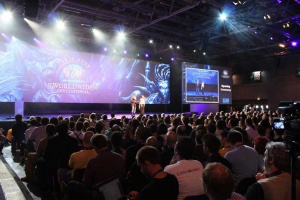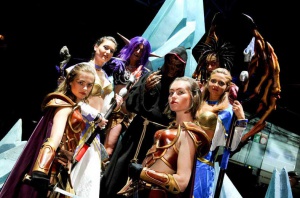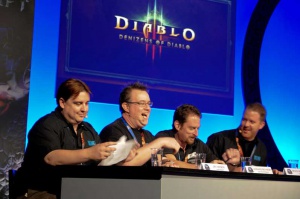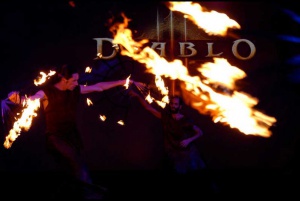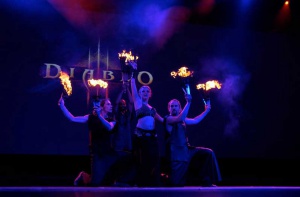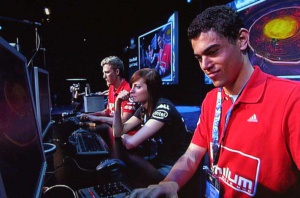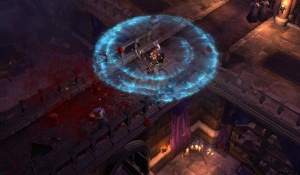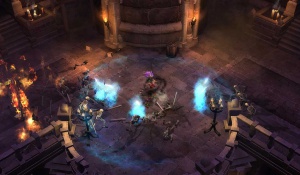BlizzCast Episode 5
When: Episode Five was broadcast on 27th August 2008
Duration: 38:37
Who: Karune, Bashiok and Nethaera discuss their WWI 2008 Paris experience and Bashiok interviews Jay Wilson, Lead Designer Diablo 3.
Contents
Introduction[edit | edit source]
| Blizzcast Index [e] | |
| Episode 1 | Episode 2 |
| Episode 3 | Episode 4 |
| Episode 5 | Episode 6 |
In this special Worldwide Invitational wrap-up edition of BlizzCast, we briefly recap some of the events at the recent WWI in Paris, and then move straight into a discussion with Diablo III Lead Designer Jay Wilson. We quiz him on how the development team is evolving the classic series -- and then dive into a discussion of some recent hot issues surrounding the upcoming sequel.
[00:14]
Part One - Interview with Karune, Bashiok and Nethaera[edit | edit source]
Karune: Welcome everyone, back to BlizzCast. We have a special episode today for you guys, our WWI follow up, and my name is Karune, your RTS community manager. Here we also have Nethaera.
Nethaera: Hello Everyone
Karune: Our World of Warcraft community manager and also we have our new community manager for Diablo 3, Bashiok.
Bashiok: Hey how's it going?
Karune: Who sounds oddly familiar with Drysc.
Bashiok: I do not, at all.
Nethaera: No, not at all. Completely different.
[00:35]
Karune: So, getting back from WWI, what did you guys think of the whole thing, especially the Diablo 3 announcement?Bashiok: I thought it was awesome, just the entire experience of being there. You know, knowing what was coming up by you know, by being involved, obviously, on the project. And just that anticipation, I think I was in the front row with my head in my hands just you know waiting for the reaction to the announcement. There was just an overwhelming explosion of noise behind me when everybody was just cheering and going off.
[01:12]
Karune: Oh gosh yeah it was so crazy, I mean Nethaera, it was your first time in Paris as well right?Nethaera: That's correct, it was just a fabulous experience and it was so great to be able to go over there and be a part of the event. You know mentioning Diablo 3, of course being able to actually say Diablo 3 now, it is a huge burden gone and just from the very first whenever you heard that first chord of music and everybody knew what happened and you got goose bumps immediately, and again I just got goose bumps just thinking about it because it's such an emotional connection to the game and to those sounds and there was kind of a hush as soon as everybody heard it, as people started to realize what was happening and waiting for that first moment.
Bashiok: Yeah.
Karune: So much anticipation oh my gosh, I just remember sitting in the first row and turning back and being like wow, everybody was just holding their breath and like everybody was on their computers ready to like just press enter, you know submit everything that they see it was so crazy, I mean it was great being surrounded by so many people with the same interests.
Bashiok: It was standing room only obviously and yeah, it was a really cool way to intro. Having the guitarist come out and play those first few chords and then launch pretty much straight into the cinematic and yeah I don't think people were, they knew what was going on I think, but it seemed like they reserved their massive applause for really like the end of the cinematic when the Diablo head came out and they were like 'Okay it's Diablo' and then that logo shows up with the three and they're like ‘Okay, here it is' and just everybody went completely off the wall.
Nethaera: Well and it was almost as if everybody was afraid of making noise and interrupting their own experience you know.
Bashiok: Yeah totally.
Karune: It was like a staggered *gasps*, 'Oh my gosh!'
*laughter*
Bashiok: It was a very powerful moment I think for all of us.
[03:06]
Karune: For sure. So what did you guys think about some of the other events that were going on at WWI afterwards? Dev Panels and you know some of the e-sports matches that were going on?Nethaera: There was so much to take in and you know I tried to get around wherever I could. I was having a good time being able to interact with some of our fan sites who were out there as well so you know that was great, getting to meet people face to face but you know it's just great whenever you get a chance to actually see a live match and hear Bunny calling it out and doing the shout cast and everything. It's just so exciting to be there.
Bashiok: Cool
Nethaera: Seeing everyone taking it all in and you know, concentrating on the action going on in the screen and getting into it with everyone else and being able to do a little geek-out with everybody, you know?
Karune: I mean the excitement levels had a peak the whole time through. For every single event I saw, even the demo stations for StarCraft 2 and Wrath of the Lich King, they were always like very, very full.
Bashiok: Yeah, long lines, it was a full blown event, there were all sorts of activities, like we had a signing table where you could get signatures from, like some of the lead artists and designers and developers and there was um the TCG section where people could go play the WoW TCG.
Karune: Oh they had that huge turtle, turtle mount that people got to take pictures of that.
Bashiok: Yeah a huge TCG turtle mount was like actually there, you know modeled out of I don't know what but people could go and sit on it and take pictures.
Nethaera: They also had the new miniature game as well for people to check out. That was there.
Karune: Oh yeah that was cool too. They gave away some of those with the goodie bags.
Nethaera: Yeah
Bashiok: Yes they did, every goodie bag came with a WoW mini I guess.
Karune: That was very cool too, the whole backpack thing, everybody running around with all their goodies. Bashiok: It was awesome there was all this other stuff in that backpack they gave us, so everybody got one that went to the event. It doubled, as you know a nice carryall for t-shirts that was another thing that was cool: the store. You could go buy posters and t-shirts. There were Diablo 3 T-shirts.
Karune: The line for that definitely was huge, right after the announcement.
Bashiok: They were smart and had 2 stores so they were able to fill orders
[05:18]
Karune: Do you remember the fire dancers? That was quite a sight to see as well.Bashiok: After the D3 announcement?
Nethaera: That was incredible, yeah. That was so cool to watch and you know, watching them manipulate that fire, sitting there thinking you know, that close and they're going to burn themselves. *laughs*
Bashiok: I was pretty sure someone was going to die.
Karune: If you guys haven't seen it already you guys have to go check it out on our video follow up to WWI on our EU WWI website. But you can probably actually pull it up on YouTube as well, I wouldn't be surprised.Bashiok: Probably
Nethaera: Oh I'm sure there's plenty of videos on that. It was really entertaining to see and it was great to see because it debuted with some brand new music for Diablo 3 as well.
Bashiok: Yeah, Nihilum had some live raids going on which I watched some of.
[06:03]
Karune: How were those?
Bashiok: It was pretty cool, I mean I'm not like an endgame raider by any stretch so it was really a lot of fun to see people there, you know actually doing the instance live and giving commentary on what they're doing, how the fights were progressing and all that.Karune: I think that's something were planning on doing more, right? Making sure, really getting the community really involved with Blizzcon, WWI. Making sure a lot of these people who put a lot of work into what they're building in these communities; to be a spotlighted representative.
Bashiok: I think it's important to bring some of the larger players to the forefront, we've been doing it for so long for like the StarCraft pro-gamers and stuff like that, but these arena guys, the endgame raiders are just as hardcore if not more. And they're like really into this stuff so, it's exciting.
Karune: Yeah, so many people who dedicate so much time to this stuff and they come up with stuff we couldn't have even imagined, developing the game.
Bashiok: I think there's a point where the players can surpass the developers to some degree in their dedication to the game, which is exciting and scary at the same time.
Karune: Good Stuff. Well, we should cut to your interview.
Bashiok: Yeah, I interviewed the lead designer on Diablo 3, Jay Wilson, talking about his experience at WWI, the development of Diablo three and some of the topics that have come up since the announcement, some of the hotter topics. So, it's going to be fun. Get ready for it.
Part Two - Interview with Jay Wilson, Lead Designer of Diablo 3[edit | edit source]
[07:47]
Bashiok: Welcome everybody to BlizzCast: The WWI special edition. I'm Bashiok your Diablo community Manager, I'm here with Jay Wilson, lead designer on Diablo 3. How are you doing Jay?
Jay Wilson: Hello, I'm good, How are you?
[08:02]
Bashiok: Very good so, you were obviously at WWI with a bunch of guys from the team
Jay Wilson: Mhmm.
Bashiok: What did everybody think of the announcement that was there or maybe that wasn't there, you family, friends when you came back?
Jay Wilson: Well, I think everybody was really excited with the announcement. We were really happy with how it all pulled off, we had so many groups in the company supporting us and trying to make it something really special and we think, we're really happy with how it turned out and, really happy with how people received it, I mean you know we expected people to like it but, when you see something every day, and you work on it for years you don't really know how people are going to react, and the overall response was so positive, and people seemed so happy so that was really exciting for the whole team.
Bashiok: Yeah I agree. The applause and cheer and everything while we were there was overwhelming.
Jay Wilson: Yeah the group that was there that we presented the game to was ten, eleven thousand people.
Bashiok: Right.
Jay Wilson: And when ten thousand people all yell at you, in good, not angry, but happily, it's like a physical force. It's pretty amazing.
Bashiok: Yeah agreed, it was a pretty powerful moment
[09:15]
Bashiok: While you were there was the most memorable moment for you outside of the actual announcement?
Jay Wilson: I think the thing I enjoyed the most was doing the autographs; you know we had an autograph table there where we would sign posters and books.
Bashiok: Yeah a signing table.
Jay Wilson: They brought Diablo 2 manuals, I think they were hoping, you know they brought lots of stuff for us to sign and it was really cool to be able to like talk to people one on one. Have the whole little subsection of the team there. We had artists drawing little impromptu sketches in people's books and that was really fun.
[09:50]
Bashiok: Yeah, who was it that was drawing houses?
Jay Wilson: Uh, Jeff Kang, one of our environment artists. He drew houses, and so I did a UI mockup because I don't really have any drawing skills.
Bashiok: A skill tree, that's exciting for everyone.
Jay Wilson: Yes, I did well I didn't want to do a skill tree cause you know it might end up on the net as the official skill tree for Diablo 3.
*laughter*
[10:07]
Bashiok: So, everybody's back from WWI now, have been for a while. Where is the development team focused right now? What is everybody working on?
Jay Wilson: Well the team's pretty big so we've got them split up on different things. Most of the art team is actually working on the second act of the game, because a lot of the team is really production focused now and we're generating content for the most part a lot of the tech and underlying engine is really solid. Most of the design team is still on Act 1 because we're refining and improving the quests and flow and some of the big game systems that we haven't really announced yet. We kind of dove back into content production fairly quickly.
Bashiok: You mentioned that art has moved on to Act 2 but design is on Act 1, or kind of spread around. How much of the development time is actually charging through to new acts, and how much is actually going back and retouching old acts?
Jay Wilson: We spend, we initially kind of work in a linear fashion, we've started at the beginning of the game and gone to the end and there's a lot of different ways you can do it but since so many of our systems are progression oriented it's easier to start at the beginning.
Bashiok: Sure
Jay Wilson: But you want your best work, which you tend to do latest in the project, to be at the beginning of the game. So what we try to do is focus. We focused on Act 1 a lot because it was just kind of the core of our game and you know, getting the game play fun and getting monsters to be cool and all of those things. Once we felt like it was good enough, we moved on to Act 2 but we'll come back to every act along the way, especially Act 1. We'll probably do a major iteration on it later in the development cycle. It's pretty much how Blizzard works; we have a tendency to iterate over and over again on everything we do. So we build something and then we rebuild it. If we haven't rebuilt something five times it really doesn't deserve to be shipped. That's pretty much our policy.
[12:15]
Bashiok: We're talking a lot about acts right now could you give any insight into the act distribution as compared to like Diablo 2? How many acts there would be?
Jay Wilson: We were originally going to go away from an act structure but we found it fell so easily into that and so we're going to a similar structure as Diablo 2. It just seemed natural, it felt right. Right now we're focusing on about the same length, about the same number of acts. I don't want to solidify because of course; you never know what'll happen. But right now we're going for about the same.
[12:50]
Bashiok: Talking about Diablo 2, everybody that played Diablo 2, or plays it – I think a lot of people are going back and playing it, since the announcement – they sort of understand the economy of Diablo 2 as a barter item based kind of system, the gold that was dropped in Diablo 2 wasn't worth much. How do you see the economy in Diablo 3 developing? And are there going to be any goals to establish trade systems?
Jay Wilson: Well, Diablo, at its core is basically a trader's game. If you look at other types of progression based RPG games, World of Warcraft is a great example. In World of Warcraft the best items are you know, held by the raiders. In Diablo the best items are really held by the traders. You know those people that are really good at trading with other people. We have no intention of destroying that design or that group of players. That being said a bartering system is actually a very exclusionary trading system; it essentially favors a very small group of elite people and it's not just that those people have entry into it. It's that anyone who wants to gain entry to that system, anybody who wants to just trade items with people, they have this huge barrier to entry, they just can't get into because they don't the value of items, they don't know what's worth what, they don't know what they need. So an elite trader would probably say, ‘Oh well, I like that I have this exclusive knowledge,' but he's actually denying himself customers essentially because there's no common language. A currency really provides a common language: that's the point of a currency. So we do want to support some kind of currency, we don't want to do some of the stuff that Diablo 2 did where they kind of actively devalued gold. We really do want to make gold, or potentially another currency – it may not have to be gold – a valuable commodity that players can use to be able to trade items. That being said it doesn't really prohibit item trading like people can use items as a currency. We have no intention of adding a Bind on Pickup or Bind on Equip, if we did it would probably be for like quest items not for actual functional, like items which people use to hack down monsters and stuff. There's nothing that's stopping bartering in that system but it does give people at least some kind of language you know if you've got two items and ones like a little bit more valuable, you can pad it with currency as well.
Bashiok: Right
Jay Wilson: Really we're trying to allow more people to get into the trading game because the more people that are in it the more fun it will be.
[15:41]
Bashiok: Of Course. So moving on to the coolest thing about Diablo – the abilities – your hero class, what you're destroying monsters with at WWI there was a lot of emphasis on art and design coming together to create a cohesive ability, you need the effect to make it look cool but you also need the design to make it function in a way that's interesting. But aside from the cool effects for the abilities; what really comes from design to request or need an ability for a class? From a design perspective what are you thinking about when you ask for an ability?
Jay Wilson: Well there are a lot of factors that go into ability selection. Some abilities satisfy those factors a little differently and that's fine. You mentioned cool factor that's an important one, you want an ability to be cool, you want a class to be cool, so if he's going to be cool his actions define that. So if he's does cool stuff he's going to be a cool class. The next one is you really want him to be archetypal. A great example with the Barbarian is we really wanted him to be all about physical force so we made some of his choices, like the changes we made to leap attack: it's a lot more forceful, it does AOE damage instead of single target damage. We did those types of things to enforce the fact that he's a very physical character.
You know the next one would be we want each class to be unique. What happens is a lot of players will request ‘Can we have 20 or 30 classes?' The answer would be yes but a lot of them are going to be really similar and we don't want that. We want each class to feel unique, to have unique abilities that are key to them. But the one that probably defines them all is really function and challenge, as we create new enemies and new challenges for the players to face, a lot of times giving the player the tools to face those challenges is in the form of an ability. If we introduce a character or an enemy who is really good at controlling the player, say he's got crazy slow attacks that make it really hard to face him, especially if you're a Barbarian, maybe the Barbarian needs some kind of way to counter that, maybe he needs an ability prevents him from being slowed or allows him to get good hits. D2, Diablo 2, had abilities like that as well, like Concentration and things like that. So function is one thing, the challenge of enemies, keeping a class archetypal, all those different things
[18:30]
Bashiok: Very Cool. So would you say that monster designs somewhat influences ability design or does it greatly influence ability design?
Jay Wilson: Greatly. Monster design and ability design go hand in hand. A lot of the times, creation of a particular monster will incite the need for a new ability or a new kind of capability on the characters and vice versa. A lot of times when we think about what monsters we want to put in the game, we think about, ‘Well what can the player do?' ‘How can we challenge them in a way given what we know about their strengths and weaknesses?' So yeah they go hand-in-hand.
[19:03]
Bashiok: So would you say that the iteration process just goes right up until the end?
Jay Wilson: Yep, as long as we're adding new enemies we're pretty much thinking about new abilities for the classes and that becomes even a greater factor as we're approaching the game in a linear fashion and a lot of the monsters right now, they're fairly simple, fairly easy to contend with. You pretty much run through the first act and one-shot everything because you're learning the game. But even going in to act 2 and act 3 which we already have a lot of monsters planned the monsters are a lot more difficult, a lot more challenging, a lot more varied and as a result, once we get in to those monsters really heavily it's going to have a big impact on what we do with the classes.
[19:47]
Bashiok: Cool. Changing gears onto the inventory, I think a lot of people noticed that the inventory management system is changing from the, I guess you call it the “Tetris” style grid system to a one-slot system where each item only takes up one slot. What were the reasons for changing the inventory system?
Jay Wilson: They're actually pretty simple. I know there is a contingent of players who absolutely love the grid system, but for the most part, it's pretty un-popular with players. With the team in general we have a lot more people who dislike it than like it. In general feedback we've gotten, there's a lot more people who are happy that it's gone than, you know, wish that it was still there. That being said, we recognize that the real purpose for the grid-based system, really one of the coolest things was that it made the items feel a little more real, because they were larger, when you were interacting with them in your inventory. So, we tried to keep that in mind and really change how the look of the items and look of the icons so when you open up your inventory the items feel more real. We're actually not even happy with that; like, some of the feedback we got on just what people saw and, the fact that there were people who were unhappy with it. It made us really go back and revisit that. Right now, we're actually trying to design a new inventory that has even larger-sized icons and, again, makes the items feel very real, and you know, that's a focus we're trying to get the best of both worlds, but ultimately we made the decision because it's not a very popular feature.
[21:25]
Bashiok: Could you comment the actually bag system? Some people saw the actual, small bags drop in the demo.
Jay Wilson: Currently, in the game we have a system where you have one inventory page and its got, I think, I can't remember exactly how many, sixteen slots I think or twelve, you know, that's how many you start with, and then you have four bag slots, and each one of those slots you can add items and as you do, it expands the number of items on that page. But we're actually; that's one of the things we are potentially going to revisit as well and we're kicking around a lot of ideas like, you know, bags that are item specific; they hold specific types of things but generally, we want people to kind of be able to upgrade their personal inventory in some way, either by removing things from their core inventory through these kind of additional bags or just expanding the inventory overall. But, none of that's final, we're actually right in the middle of a big redesign on that whole system.
[22:27]
Bashiok: Cool.
On the same vein of item storage, anybody that played Diablo II, to a great extent, or maybe a medium extent probably had item mules, which were characters specifically created just to hold items for your main characters. What are your thoughts on mules? Are those going to be coming back? Do we see a need for them in future Diablo titles?
Jay Wilson: Well, I think as long as there is limited inventory space, which pretty much as long as there's limited hard drive space there's going to be limited inventory space, you're going to have people who are going to want to mule, like, you want to store items. Storing items is fun, like collecting items is fun; that being said, the way that people had to do it in Diablo II was not fun at all. So, what we're going to be looking at is, you know, generally we don't want to encourage mulling, we don't want to make it the way people want to do- simply because the way it was done in Diablo II wasn't fun. So, we're going to make a lot of changes overall to how inventory's done. One of the first probably- I think all these changes will actually be quite popular, which is one of them is going to be we're going to give people more inventory in general- just a little bit bigger inventory. It's also easier with a one-slot system actually, because you don't have the items eating up so much screen real estate, you don't have the risk of an especially large item just destroying the inventory space, but creating tons and tons of room for lots of little items. So, we have a lot more control with that. The other one is we're going to give people lots of ways to expand and deal with your inventory and… more info on that, coming in the future. And then, the last one is we really want to make it easier for you to be able to share and trade items with other people and other characters on the same account. We've talked about ideas like a shared stash, or a mail system like World of Warcraft has, and we haven't nailed down exactly which one of those we want to do, but we're definitely going to do something like that, that's going to make it really easy for you if you've got, a witch doctor and a barbarian character, and you find that awesome witch doctor drop and you want to share it, it'll be super-easy to do that.
[24:37]
Bashiok: so in other words, I won't have to worry about my game closing after...
Jay Wilson: No, no more opening up a game, dropping items on the ground, and you know, hoping that the game stays open or getting a friend to help out, no more of that. You should be able to do it on your own.
[24:48]
Bashiok: Awesome. Some fans of the, grid-based system though, argue that the size of the item in your inventory kind of equated to its value to some degree- if it was a huge item, it was, I guess it would offset some of the power of the item. So you had like, a grand charm, it took up three slots so you know, it was kind of like you were weighing the advantage of holding the item in your inventory. What do you think of people that, I guess, hold that stigma?
Jay Wilson: I think there's some truth to that, primarily with charms, but then I think anybody who looked at the charm system would probably say, ‘yeah but I don't want a bunch of charms taking up my inventory. Like, inventory is for inventory, charms should be separate.” But, as far as other items, like, “I'm not going to carry this suit of armor because it's really big and I can carry rings that sell for more,” that's not really much of a choice and it's pretty obvious what the best choice there is- to just carry smaller items. So, there is some game play to that, but, you know, I don't want to dismiss it, and like any other design decision there's a tradeoff, but ultimately, so many people disliked the grid system overall that the benefits of it just did not outweigh that general kind of aggravation that people had with it.
[26:13]
Bashiok: So, from my viewpoint, probably from a lot of people's viewpoint, the announcement was extremely positive. But it seems like a lot of the Diablo II players, or at least the hardcore Diablo II players want to see the necromancer come back or perhaps other classes coming back. Obviously, the barbarian's one of the ones you're bringing from Diablo II. What are your generally feelings on bringing classes back the previous games?Jay Wilson: Well, for the core game, you know, the kind of initial release of Diablo III, we really want to establish our own identity, like we don't want to just remake Diablo II or Diablo I, we want to provide a unique game experience for people. So, on that front we're really only going to consider bringing back classes that we feel we can improve-the necromancer is an awesome class, actually my favorite class, from Diablo 2, and the class I'm currently playing the most of- its not that we just dislike him, he love the necromancer, but part of his, you know, the issue we have is, he was so well-designed, I mean, you've got your corpse explosion, you've got your skeleton sum, pets and you know, hordes of those guys running around and killing things, you've got curses, like, it's across the board a very well-designed class and there's certainly some things we could do a little differently, but do we feel like we can make him so much better, and change his core gameplay experience. If anything, we'd say we really don't want to, like he plays too well. Whereas with the barbarian, we really looked at the class and he's cool but he could be a lot cooler and he could have a lot more that he does, over the previous game. So, you know, that's why the necromancer is not being seen.
A lot of people have looked at the witch doctor and said “oh, the witch doctor is so similar to the necromancer, he's not going to be there, there's no chance for the necromancer ever.” I wouldn't go that far, we are trying to make sure that the witch doctor, while he has a lot of similarities is very different overall. One of the core differences is that the witch doctor is very attack oriented- people remember back to the gameplay video, almost all the monsters that got taken out were taken out by the witch doctor, not by his pets. So that's kind of a key difference between him and the necromancer, is that the necromancer was very often, his pets were critical to his damage output, whereas the witch doctor uses his pets as a distraction and a utility. So we try to keep them different that there's the possibility down the road, but that would maybe be an expansion or something like that after we felt like we've kind of established core Diablo III game. That being said, I wouldn't expect, I would tell people not to expect any other Diablo II or Diablo I classes appear you, know, in the exact same form that they did- if we did bring back another class it would be a radical change.
[29:18]
Bashiok: And lastly, we're moving on to something that's created a bit of a stir, was critiques of the art style for Diablo III. People feel that the tone isn't dark enough, it's too bright and colorful, there's a rainbow- what do you feel the team's feelings on the sort of critiques that we've received?Jay Wilson: Ah, the art question. This one's pretty complex, um, so you know, I can first say that the response from the team has been, that really what we've heard is kind of an overwhelmingly positive response. We know that there are some people that are very concerned with the overall tone of the game and tone of the art, and, kind of what we wish we could do is take them through the last two and a half years of, you know, where we basically, created and dumped two complete art style directions. So, I'll kind of go through and explain all the reasons that we went into this decision.
So, the original two art styles that we did were probably more in line with what some of the sample shots that people put up online of what they were hoping the game would look like, and, you know, they were very dark, they were very monotone, a lot of grays, a lot of brown, not a lot of color. And the problem we had was that it just didn't produce a very good game for us. Diablo is game that you spend hundreds of hours in as opposed to, if you look at a lot of the current round of very realistic, very grim, gritty games, you know, a lot of those are five, six hour games. So, a gray-brown environment, gets old very quickly when you're playing it for, tens or twenty, you know, a hundred hours potentially. So really, environment change was a critical part of Diablo II. What made Diablo II so compelling was, the environments changed drastically very often. So, if your environments are all kind of grey-brown it doesn't work. So the other one was that we, it was actually not very easy to play the game; Diablo is a game where you fight a lot of monsters and not just a high number of monsters, but a lot of different types at once and you're facing, three, four, five different types of enemies at a time. So being able to identify those enemies was critical. And what we found was, again, when we made the enemies that very realistic dark, gritty look, like the environment, they all just kind of blended together, and again, it made the game not very fun.
So, at that point, after we had done this twice and gone, “wow, we really don't like the results here, we started going back to Diablo II in particular and looking at it, trying to figure out what Diablo II did, that worked so well. What we found was that a lot of the ideas that made Diablo II work well, just didn't translate well to 3D. We also found a very different game than a lot of us remember, even though a lot of us played the game still, like a lot of us are still big Diablo II players, we still have kind of this idealized vision of it where we really remember, like, Durance of Hate and act I dungeons and we kind of conveniently forget, you know, the act II desert and the really bright lava hell levels and the things like that that are filled with a lot of color. And we saw that and we were kind of surprised. We were like, “wow, look at how green the fields are in act I, look at how much color there is in this world.” We also were kind of surprised by the monsters, the monsters are really almost garish in Diablo II, they're very, very bright. And this makes them, you know, you'll have like a bright red fallen next to a bright blue, I think they're called blood hawks, somebody's going to lambast me for not getting the name right. And you've got a corrupt rogue who's bright white and then you've got these, you know, big, hulking windigos that are brown and, you've got all these different color palettes all at once, and they're all very, kind of out there and garish; the reason is so you can tell each one apart. You've got a big guy who's brown, you've got humanoid person who's white, you've got a squat humanoid who's red, you've got a bird figure who's blue, like each one has a different profile, each one has a different color and they all really stand out.
So, we tried that idea, and it didn't work. Once you took that idea of very bright, very garish monsters and put them into a 3D environment, it was almost like taking a comic book character from the pages of a comic book, and putting them in a movie- the suits don't translate, those primary colors don't work. And so, with the higher resolution, and things like that, so we had to explore other options. And essentially, that's what brought us to this current art style, where we really focused on, well, a couple things. One, we decided that we really didn't want to make- we did want to make a kind of a realistic-looking world, but we also decided that realistic just does not equal gray and brown. The real world's filled with all kinds of colors. We also decided that we didn't want to make, while we wanted to make a more realistic world, we didn't want to make a photo-realistic world. Again, a lot of games are doing that, it's not what Blizzard is about. We wanted to see if we could create a game that visually had an art style that was unique- that's stylized without being cartoony. So, I know that's kind of a lot of information, but it's probably our biggest struggle with Diablo, was Diablo III was trying to the art style right, and we're really proud of how it turned out and so, that's just kind of my effort to explain how we got to where we are.
[35:18]
Bashiok: Perfect. I think also, something that I heard around the office, we've been talking about the reaction to some degree; one of the things that I thought was really interesting was, I guess, tone in context. Can you explain it to people listening just what that kind of means?
Jay Wilson: Well, you know, there have been some great comments that we've seen on the forums that, some people have commented, for example, after fight's over, the bodies fade away, and this is done for physics- I mean, physics systems pretty much, you know, if you want to keep a game running fast, you can't keep too many physics objects in the world, but then, you know, it's a good point that, where's the massacre? You know, I just killed a bunch of monsters, and, it makes the game feel like the tone is not quite right. So we're actually working on a different way to handle bodies that we're hoping will result in that same level of carnage.
But yeah, it's all about getting that tone right, and that's something we focus a lot on. We really want to make sure that the tone of the game is right, that its dark, that its foreboding. And that's something that I think when people actually play the game, they're not going to have any doubt that it's a Diablo game. Every person we've sat down in front of it, for the first time, hasn't seen anything and started playing it they were like, “yeah, this is dark, because this feels right.” But, for the game play sake, we wanted an art style that supported, you know, all the kind of game play that we wanted. It's also worth mentioning that, what we showed at WWI really is a very early game content, you know, it's first act, first act dungeon, first act environments. And, we've made a conscious effort to make sure that the tone gets worse- one of the things that we really want to tell a story of, basically, the coming apocalypse, and it works best if there's a contrast, you know, if things get worse in act two and act three, and act four, and visually, as well as just story-wise then it makes a big difference in kind of, how the tone feels, it feels like you get the nice contrast, or contrast between an idyllic world even though I wouldn't call any Diablo world that we've created, idyllic. But, for Diablo, it's probably idyllic, and then you know, at the end, just hell let loose. That doesn't mean we're going to back off from color, it doesn't mean that we're going to back off from the stylization that we're going for, but it does mean that yeah, people are probably going to see some environments that feel, tone-wise, a lot more, menacing than what we've shown so far.
[38:01]
Bashiok: Perfect. And I think people are going to look forward to, Blizzcon's coming up, obviously we're going to be showing something new there; what it will be, I don't know. But, I wanted to thank Jay, for coming out and talking to us
Jay Wilson: No problem
Bashiok: This has been Bashiok, for the special edition BlizzCast, wrapping up, WWI. Thanks for listening!
BlizzCast Resources[edit | edit source]
- Download Episode 5 in .mp3 format 70.9mb EU Mirror US Mirror
- RSS Feed
- Official Blizzcast Site
| Blizzard Entertainment & other Game-related Topics [e] Blizz Games Other Games Terms Devs Blizz ppl D3 D2 D1 Other ppl Events Merchandise Related |
|---|
| Blizzard's Games |
|
|---|
| Game Developers |
|---|
| Blizzard People |
Blizzard's Top |
Blizzard All |
Blizzard All cont. |
Ex-Blizzard |
|---|
| Diablo II Team |
|---|
| Diablo I Team |
|---|
| Industry People |
|---|
| Diablo Merchandise |
|
|
|
|
|---|
